Boletus mushroom
The boletus mushroom is a whole genus belonging to the Boletovye family, class Agaricomycetes, department Basidiomycetes. There are about 300 species, most of which are edible. Distributed throughout the Northern Hemisphere, except for tundra, steppes and deserts. It is considered one of the most valuable edible mushrooms.
- Description
- Growing places
- Edible species
- Porcini
- White birch
- Oak
- Bronze
- Burroughs
- Bicolor
- Yellow
- Golden
- Royal
- Porosporous
- Adnexal
- Fechtner
- Horton
- Common Dubovik
- Semi-white
- Maiden
- Conditionally edible species
- Wolf
- Beautifully colored
- Dubovik Kelle
- Speckled oak
- Flywheel red
- Hare
- Inedible species
- Beautiful-legged
- Rooted
- Le Gal
- Beautiful
- Pink-purple
- Pink skinned
- Satanic
- Conclusion

Boletus mushroom
Description
Boletus mushrooms are considered one of the largest cap varieties. They weigh 200-300 g, sometimes they reach a kilogram. The record holders grow up to 2-3 kg. These fruits look like this:
- the fruit body is massive, dense;
- the leg is thick and dense, with a characteristic thickening at the base or in the center, sometimes it has a barrel-shaped shape;
- leg height - 3-20 cm;
- the shade of the leg is light, sometimes reddish or brown, with a characteristic mesh;
- the surface of the leg is rough, sometimes smooth;
- the hat is wide, flat, or resembles a pillow, with a diameter of 5 cm to 25 cm;
- the color varies from light yellow and beige to dark brown and almost black;
- the surface of the cap is velvety or smooth, after rain it becomes slippery;
- hymenophore tubular, dense, color from yellow to olive, sometimes reddish, rarely white (in young specimens);
- spores are yellowish, brown or olive-brown;
- the flesh is white, dense, crunchy with a pleasant mushroom smell.
Edible boletus mushrooms are delicious, they belong to the 1-2 category in terms of culinary value. Many species remain light colored after processing. The pulp exudes a strong mushroom aroma, which intensifies when dried.
Mushrooms are prepared in different ways: boiled, pickled, dried, salted and frozen. They contain many beneficial substances. They are eaten for anemia, problems with bone tissue and joints. But this food is hard on the digestive tract.
Growing places
Boletus habitats are located in the temperate zone of the Northern Hemisphere. The largest yields of these mushrooms are harvested in the forest zone and taiga, less often boletus grows in the forest-steppe. This representative of the genus Bolet does not grow on the territory of the tundra, forest-tundra and steppes. Boletus is also found in the forests of mountainous areas. The closer to alpine meadows, the less often this mushroom is found. At an altitude of 1500-2000 m above sea level, it does not grow.
The name itself says that boletus is found in the forest. They love coniferous forests, grow near pines and firs. They are met next to oaks, chestnuts, beeches and hornbeams. Boletus appears less often in the birch-coniferous and deciduous forest.
The mycelium envelops the roots of trees, but the fungus is not a parasite, it forms a symbiosis - micrisa. Without it, Bolette will not grow, because nutrients enter the tree through the mycelium, and organic products go back to the mushroom.The mushroom also requires a certain type of soil, which is formed only in the forest. This makes it difficult to grow the species at home or on an industrial scale.
They begin to collect boletus already in June, but the peak season is in August and September. If the fall is cold, the mushrooms disappear quickly. In the southern regions, the first forest boletus appears in May and grows until the end of October. Fruit bodies grow in humid and warm weather, they live no more than a week.
When searching, it is worth carefully examining the litter under the pines, fir trees, hornbeams, oaks and beeches, places near anthills. Young specimens are small, hiding under leaves. Boletus rarely grow alone, if you draw a circle with a diameter of 10-15 m around the found specimen, then within it you will find a whole family.
Edible species
The edible boletus species are the most popular. They are found in summer and autumn in coniferous, deciduous and mixed forests. These mushrooms have similar characteristics. Many people find different types, but give them a common name.
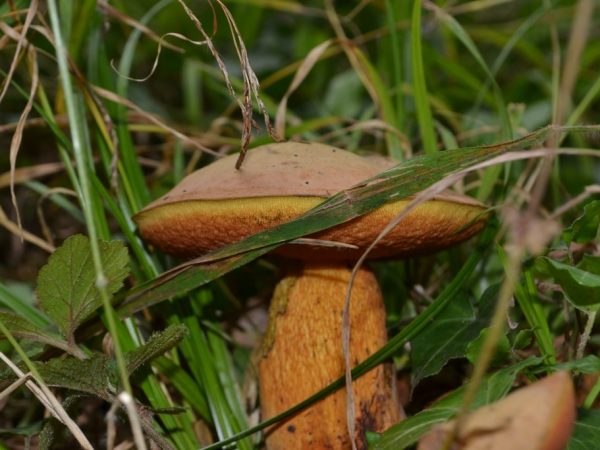
Porcini mushrooms are valued for their taste.
The most common edible varieties are:
- white;
- birch;
- oak (mesh);
- bronze (spikelet);
- Burroughs;
- two-color;
- yellow;
- golden;
- royal (woody);
- porous;
- subordinate;
- Fechtner;
- Horton;
- ordinary oak tree;
- semi-white;
- maiden.
Porcini
Boletus boletus is the most famous species. It got its name because of the light shade that remains during boiling and drying. The cap in young specimens is semicircular, cushion-shaped, then becomes flat in older specimens. Shade from beige to light brown. The hymenophore is white at first, turns yellow or becomes greenish. The leg is elongated and thickened, it grows up to 20 cm, has a barely noticeable mesh pattern. The pulp is firm, has a white color and does not change color on the cut.
The white fungus appears more often in the upland from the beginning of June. Further growth occurs in mid-July, August, and the first half of September. The season ends in October. Productivity depends on the weather, the largest - in warm, humid summer or autumn.
White birch
The birch look is similar to the regular white. The main difference is that the fruit body is lighter, in young fungi it is almost colorless. It grows up to 15 cm. At an early age, the cap has the shape of a pillow. The leg is whitish-brown with a mesh on top, looks like a barrel. The middle is dense, white, the color on the cut does not change. Mushroom aroma.
Most boletus is found near forest paths, glades and clearings. This species is widespread in the territories from the west of Siberia to Murmansk and northwestern Europe. Unlike the classic white boletus, it prefers not pine, but forest mixed with birches.
Oak
A large mushroom, its cap sometimes grows up to 30 cm, the thickness of the leg is 4-7 cm, the length is 10-25 cm. The top is coffee-colored, brown, grayish with brown, nut-brown, ocher. Walnut leg with white or brown fine mesh. The pulp is compacted, in older specimens it is spongy and springy, with a pronounced mushroom aroma.
Boletus reticulated appears in May and grows until October. Fruiting bodies are found under oak trees, sometimes they grow under beeches and linden trees. This species is widespread in the mountains and foothills, rarely found on the plains.
Bronze
Bronze boletus is a rare species found in the southern regions of Russia. It has a dense, squat fruiting body and grows in a single specimen or in a group. The hat is dark brown with a bronze tint. The leg is brown and mesh. The pulp is dense, white at the cut, but after a couple of minutes it darkens a little. The taste is refined, the smell of mushroom and delicate.
Burroughs
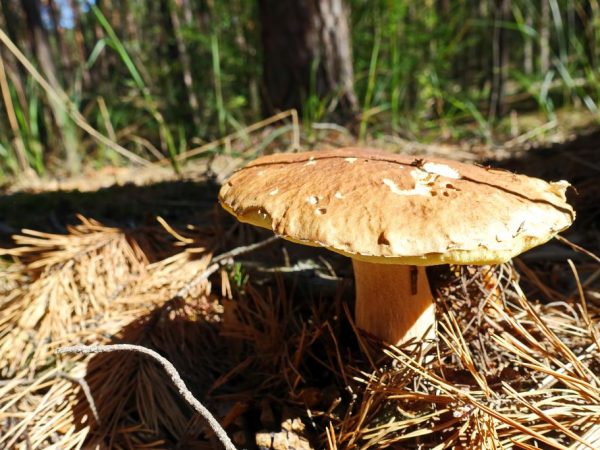
The mushroom hat can grow up to 25 cm
Burroughs' fly grows in the North of America. It has a large, fleshy cap, with a whitish or yellowish brown dry skin. In young specimens, it is rounded, then spreads out. The diameter sometimes reaches a quarter of a meter.The lower part of it (tubular hymenophore) is first white, then turns yellow-green. The leg is in the shape of a club of medium thickness, high, with a whitish mesh. The pulp is white, does not change on cut, has a strong aroma.
Bicolor
Boletus bicolor is another American species that grows in forests of coniferous and deciduous trees. The mushroom cap is a deep red color with a slight pinkish tint. In young specimens, it is convex, then it becomes flat. The hymenophore is yellow, like the pulp, turns blue on the cut. The leg is pink-red, of medium thickness, mesh.
Yellow
Borovik yellow - a rare species, it is found in the west of Europe and in the Ussuri region of Russia. Grows in forests with oaks and beeches. The cap is yellowish-brown, slightly convex, then (as it grows) flat. The skin is wrinkled, but it can also be smooth. The tubules are light, 10-20 mm long. Leg without mesh, covered with dark dots and scales. The pulp is bright yellow, quickly turns blue on the cut, odorless.
Golden
Boletus golden used to be found only in North America, but now it is found in Europe. The cap of the golden boletus is slightly rounded, with a reddish-brown tint, dry and velvety. The hymenophore is yellowish or olive, with a notch at the stem, turns yellow when pressed. Leg with a pronounced mesh, slightly ribbed in appearance. The pulp is firm, does not change on the cut, the taste is sour, the aroma is weak.
Royal
Royal boletus is a small stocky mushroom with a red-pink cap, which turns pale as it grows. The shape is initially convex, over time it becomes flat, and a notch appears in the center. The tubules of the hymenophore are elongated, greenish-yellow. The leg is yellowish with a mesh on top. The pulp is of the same color, turns blue on the cut, the mushroom aroma is pronounced, the taste is pleasant. This variety grows in deciduous forests, prefers symbiosis with beeches.
Porosporous
Porous boletus in appearance resembles a flywheel. He has a small gray-brown hat with numerous whitish cracks. The hymenophore is lemon yellow, if you press on it, it changes color to blue. The leg is gray-brown, dark underneath. The flesh is whitish, compacted, acquires a blue tint on the cut. The mushroom is tasty, there is a light fruit aroma. Grows next to conifers, less often broad-leaved trees.
Adnexal
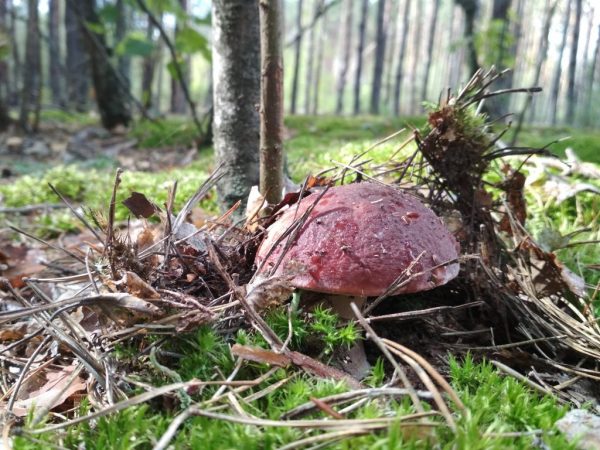
Adnexal boletus is rare
A rare mushroom that prefers to grow in the southern regions of the temperate zone. The subordinate boletus has slightly rounded or flat caps, they are colored from yellowish brown to brown, the skin is velvety. The flesh on the cap is dense, the hymenophore is thin, with rounded tubes, when pressed, it acquires a blue-green tint. The leg has a lemon shade, there is a mesh that disappears in older specimens. The shape of the leg is cylindrical or clavate, the height is up to 12 cm (with a cap diameter of 7-20 cm). The middle is yellow, which changes to blue at the cut.
Fechtner
Boletus Fechtner grows on alkaline soils enriched with limestone, prefers broad-leaved forests. The hat of this species is silvery-white, at first velvety and with wrinkles, then it smoothes out, and becomes slippery at high humidity. The hymenophore is yellow, concave near the stem. The leg is yellowish from above, from below - red with brown, has a mesh pattern. The shape of the stem is tuberous, with a thick base. The pulp is fleshy and dense, takes on a delicate blue tint on the cut, the smell is weak.
Horton
Boletus Horton is a small fungus that grows in oak and beech groves. The hat has a diameter of 4-10 cm, red-brown or ocher-brown color. Its surface is velvety and wrinkled. The hymenophore is yellow to olive in color, does not turn blue when pressed. The leg is in the form of a club or a cylinder, smooth, without a mesh, reddish. The pulp is whitish or yellow, not aromatic and tasteless.
Common Dubovik
Boletus, or oak tree, is a common species that appears in the last weeks of May. Then it grows in the second half of August and until the end of September. The hat is large. The shade is uneven, on the surface it has brownish-yellow, gray-brown spots. The hymenophore changes colors from ocher to dirty olive, thin, with small tubes. The leg is thickened, clavate, yellowish at the top, reddish-brown at the bottom, with a pronounced dark mesh. The pulp is yellow, turns blue on the cut, and then turns black. The smell and taste are almost not expressed.
Semi-white
The semi-white boletus mushroom is a thermophilic species, therefore it grows in the south, in coniferous and mixed forests. The hat is light clay, reddish or light gray. Sizes - 5-20 cm, the skin of young specimens is velvety, in old specimens it is smooth. The hymenophore is golden or green-yellow in color. The leg is low, up to 10 cm, at first tuberous, then stretched out, acquiring the shape of a cylinder. Above it is rough, the shade is yellow, below it is red, the mesh is dotted. The middle is yellow, on the cut it becomes light pink, the taste is sweetish, there is a slight smell of carbolic acid, especially at the leg.
Maiden
The maiden look is now not attributed to the genus Borovik (Bolet), but in appearance it resembles its distant relatives. The mushroom has a flat cap with curved edges, the diameter is from 5 cm to 20 cm. The skin is velvety, yellow or red-brown. Hymenophore 1-2.5 cm, lemon, then brown. The leg tapers at the base, its thickness is 2-6 cm, there is a lemon mesh. The pulp is yellowish, turns blue on the cut, has a pleasant mushroom smell. Boletus maiden grows in deciduous forests of Southern Europe.
Conditionally edible species
Conditionally edible species are those that require additional processing during cooking. They have a bitter or pungent taste, an unpleasant smell. It is advised to boil such mushrooms 2-3 times or soak them in water for several hours. They belong to the 3-4 category in terms of culinary value.
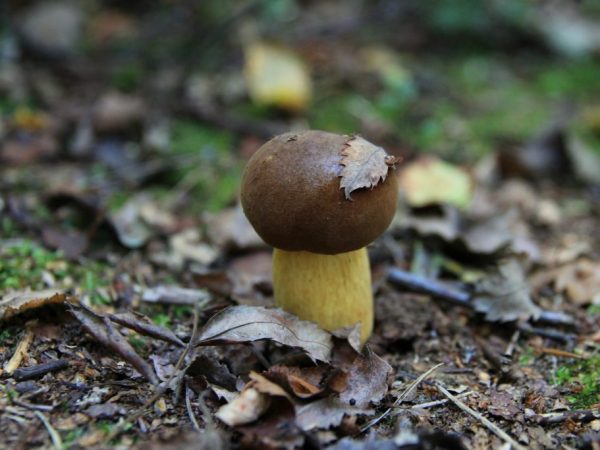
Some species require pre-soaking
The most common conditionally edible species:
- wolfish;
- beautifully colored;
- oak tree Kelle;
- speckled oak;
- the flywheel is red;
- hare.
Wolf
Boletus wolf grows in the Mediterranean and northern Israel, forms a symbiosis with oak trees, appears in November - January. His hat is small, 5-10 cm in diameter, with a pointed edge, always has a pink or red tint against a brown background. The skin is dry, in young specimens it is covered with a felt bloom. The tubules of the hymenophore are first yellow, then turn red.
The leg is bright yellow, with darker dots, smooth, without a mesh. Height - 4-8 cm, diameter - 2-6 cm. The pulp is dense, yellow, then turns blue, does not have a special aroma and taste. Before use, the mushroom is boiled 2 times for 15-20 minutes, the water must be drained.
Beautifully colored
The beautiful boletus got its name from the delicate pink skin on the edges of the cap. The skin color is light gray, it is rough, covered with felt, and becomes smooth over time. The tubules are olive yellow, easily separated from the fleshy part. The leg is bright yellow, tapers below. The pulp is firm. When cut, it takes on a pale blue or light blue tint.
In young specimens, the aroma is fruity, then deteriorates. The taste is not good. Raw, beautifully colored boletus is poisonous. If soaked and boiled 2-3 times, it is good for food, but not tasty. Therefore, it is rarely harvested, classified as inedible.
Dubovik Kelle
Oak Kelle prefers acidic soils, grows in oak groves, less often in coniferous forests. It is found in clearings in tall grass and moss. The hat is brown, occasionally has a yellowish tint. In dry weather, soft and velvety, after rain, sticky and slippery, like an oil can. The leg is yellow, 2-5 cm in thickness and up to 10 cm in height, covered with red scales. Mycelium threads are clearly visible at the base.
The flesh on the cut immediately turns blue, sourish in taste, weak aroma, never wormy. This species contains substances that irritate the stomach. Before use, it is soaked for 5-10 hours, then boiled for 30-40 minutes, the broth is drained. After frying or stewing, the mushrooms are ready to eat.
Speckled oak
Speckled oak tree is sometimes also called grainy-footed. It appears in the forests from the end of August and bears fruit until October, in the southern regions it is found already in May. The hat is fleshy, in the shape of a brown pillow with different shades of red on it. The hymenophore in young specimens is yellow-olive, turns red with age. The stem is in the form of a tuber or a barrel, reddish-yellow, with numerous red scales and specks. The middle is bright yellow, at the base the knives are reddish. Turns blue on the cut. The mushroom is eaten after boiling twice a day.
Flywheel red
The red flywheel is a false boletus belonging to a different genus. Previously, he was included in the pains. It is rare, representatives of this species grow in deciduous forests, near old roads, clearings. Has a fleshy and fibrous head in the form of a pillow. The shade of the skin is cherry, purple, rose-red. The hymenophore ranges from golden yellow in young specimens to olive brown in older specimens. The leg is yellow-brown, lighter on top, with reddish scales. The pulp is yellow, slightly blue at the cut.
Irina Selyutina (Biologist):
The red flywheel, or the red boletus, is referred to in 4 categories of edibility. The first fruiting bodies appear in August - September. Grows in deciduous forests. Prefers oak groves.
Due to the fact that it is not often found, it is collected along with other mushrooms - "along the way." The flesh of the leg in its lower part has an interesting and characteristic feature: red dots.
Little is collected of this species, not only because it is rare with a wide dispersal (range), but also because fruiting bodies are very often affected by worms, which makes collection unrealistic.
Hare
The rabbit mushroom belongs to the Boletaceae family, but is not a boletus, although their description is similar. It is sometimes called chestnut or false white. The hat is reddish-brown or red, has a velvety or, as it were, powdered top. The hymenophore is white, turns yellow with age. The stem is in the form of a cylinder or club, in young mushrooms it is dense, in the aging it is loose, with chambers and voids. The middle (pulp) is white, does not change color. When boiled, it becomes bitter, if it is dried, this property disappears. It will be possible to find the hare mushroom until mid-November.
Inedible species
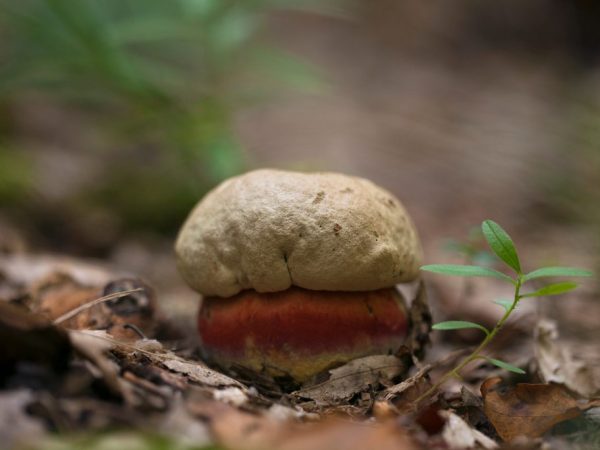
Poisonous mushrooms can cause severe poisoning
The genus Borovik includes a number of species that are unsuitable for human consumption. Among them there are toxic and even deadly poisonous. All of these varieties have specific characteristics. You should definitely familiarize yourself with them in order to understand the difference between the species, and not to put a poisonous mushroom in the basket.
Common poisonous and inedible species:
- beautiful-legged;
- rooted;
- Le Gal;
- beautiful;
- pink purple;
- pink-skinned;
- Satanic.
Beautiful-legged
Beautiful or beautiful-legged is an inedible, but not poisonous species either. His cap is olive or light brown, dry, fibrous in young specimens, the edge is wrapped with age. As the mushroom matures, the hymenophore changes its color from lemon yellow to olive. It is thin, the tubes are pink in color, and turn blue when pressed. The leg first resembles a barrel, then a mace or cylinder. Above it is yellow, in the middle it is carmine-red, below it is reddish-brown, in aging fruit bodies it is almost colorless. The middle (pulp) is firm, creamy, with a bitter taste. It grows under fir trees, less often under deciduous trees.
Rooted
Root boletus, or stocky, loves warmth and prefers the root system of deciduous trees to create mycorrhiza.This boletus is inedible, but not toxic either. The cap sometimes grows up to 30 cm. The shape of a pillow or hemisphere, the edges are bent, in old mushrooms they are wavy. The color is light gray with a fawn or greenish tint, the surface is dry. The hymenophore is yellow-olive, turns blue when squeezed. The leg is lemon on top and olive on the bottom, with a fine delicate mesh, short. The middle is dense, has a pleasant aroma, but a bitter taste.
Le Gal
Borovik le Gal was discovered by the French scientist Marcel le Gal, after whom he got his name. The name "legal" is also found in the literature. Grows in deciduous forests, under oaks, hornbeams and beeches, it is poisonous. The hat is pink-orange, at first spherical, then convex and outstretched. The hymenophore is tubular, its constituents (tubules) are red, adherent to the peduncle with denticles. The middle smells like a mushroom, whitish or yellow, turns blue when cut. The leg of the same shade as the cap is covered with a red mesh, the shape is barrel-shaped.
Beautiful
Boletus is found on the west coast of the United States during the summer and fall. It is toxic, causes indigestion and diarrhea, but has not been fatally poisoned. The hat has a specific reddish tint, sometimes olive brown. The tubules of the spore-bearing layer are yellow-green, the pores are blood-red. The leg is swollen, reddish with a brown and characteristic purple or scarlet mesh.
Irina Selyutina (Biologist):
Belonging to the category of poisonous mushrooms, the excellent boletus is capable of causing stomach upset. After a while, the symptoms (diarrhea, nausea, vomiting, abdominal cramps) disappear without a trace. Fatal cases as a result of boletus boletus poisoning in areas of its natural growth (mixed forests of the American west coast and the state of New Mexico) have not been recorded.
The pores of the hymenophore are painted in a rather bright color - blood-red and when pressed on them acquire a blue tint.
This fungus is mycorrhizal. Forms a fungus root only with representatives of coniferous tree species.
The fruiting season begins in late summer and lasts until the end of autumn.
Pink-purple
Boletus purple, or pink-purple, has a characteristic cap color. On a gray background, there are spots of wine, purple, brown-red or pink shades. If the fruit body is turned over, blood-red pores are visible, while the hymenophore itself is olive yellow. The leg is clavate with a thickening at the bottom, covered with a reddish mesh. The middle (pulp) is firm, with a sour-fruity odor. On the cut, it first turns blue, then blackens, and over time becomes wine-red. The species grows on limestone soils, in deciduous forests.
Pink skinned
Pink-skinned boletus is a rare species. It causes upset stomach, diarrhea, if the doses of the mushroom eaten are high - convulsions and loss of consciousness. The hat first takes the shape of a ball, then a pillow. The color is brown-gray with a reddish bloom at the edges, the surface is smooth or velvety. The pores are yellow at first, with time they acquire a scarlet hue or carmine color, the tubes are olive yellow. The leg is lemon on top, bright red below, covered with a reddish mesh. The middle is lemon yellow, turns blue when cut.
Satanic
A satanic mushroom, or a satanic mushroom, looks specific, it is difficult to confuse it with ordinary white. The hat is light gray, it can be olive or ocher-colored, pink stains are often visible on it. Upon closer examination of the hymenophore, it becomes noticeable that the tubules are yellow-green or yellow-olive. The pores change their color from yellowish to reddish, carmine and blood red. When pressed, they turn blue.
The leg is yellowish, carmine or orange on the cut. Top covered with a red mesh with rounded cells, tuberous shape, tapering at the top. If the mushroom is cut, it first turns red, then turns blue, old specimens smell unpleasant.The fungus causes damage to the liver, nervous system, spleen.
Conclusion
Boletus or porcini mushroom is the most popular species. It represents the vast family of Boletaceae, which includes more than just edible varieties. Before going to the forest, it is important to carefully read and, most importantly, to remember the description of useful and dangerous mushrooms or false boletus. Growing at home is difficult.


